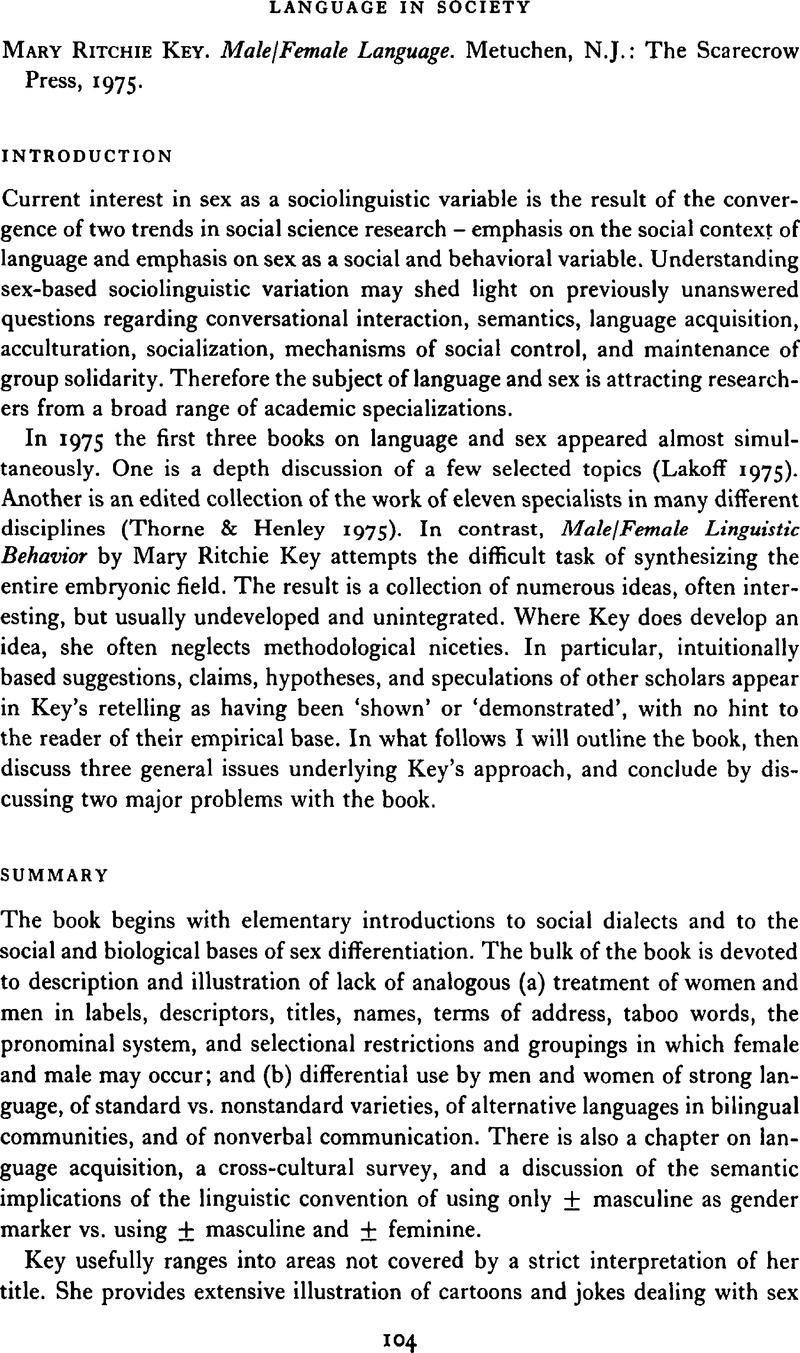No CrossRef data available.
Article contents
Mary Ritchie Key. Male/Female Language. Metuchen, N.J.: The Scarecrow Press, 1975.
Published online by Cambridge University Press: 18 December 2008
Abstract
An abstract is not available for this content so a preview has been provided. Please use the Get access link above for information on how to access this content.

- Type
- Book Review
- Information
- Copyright
- Copyright © Cambridge University Press 1977
References
REFERENCES
Atkinson, K., McWhinney, B. & Stoel, C. (1968). An experiment on the recognition of babbling. Papers and reports on child language development. Stanford.Google Scholar
Blackburn, R. (1967). Representation of New England rustic dialects in the plays of Eugene O'Neill. Unpublished dissertation, New York University.Google Scholar
Brown, J. K. (1975). Iroquois women: an ethnohistorical note. In Reiter, R. R. (ed.), Toward an anthropology of women. New York: Monthly Review Press.Google Scholar
Friedl, E. (1975) Women and men: an anthropologist's view. New York: Holt, Rinehart & Winston.Google Scholar
Hoffer, C. P. (1974). Madam Yoko: ruler of the Kpa Mende Confederacy. In Rosaldo, M. Z. and Lamphere, L. (eds), Women, culture and society. Stanford: Stanford University Press 173–87.Google Scholar
Reprinted in J. Williamson & V. Burke (eds) (1971). 145–77.Google Scholar
Reprinted in J. Williamson & V. Burke (eds) (1971). 22–9.Google Scholar
Leacock, E. (1972). Introduction to F. Engels. The origin of the family, private property and state. New York: International Publishers.Google Scholar
Leacock, E. (1974). The structure of band society. Reviews in anthropology I (1). 212–21.CrossRefGoogle Scholar
Leacock, E. (1976a). Class, commodity, and the Status of women. In Rohrlich-Leavitt, R. (ed.), Women cross-culturally: change and challenge. The Hague: Mouton.Google Scholar
Leacock, E. (1976b). Women in egalitarian Society. In Bridenthal, R. & Koonz, C.. (eds), Becoming visible: women in European history. Boston: Houghton Mifflin.Google Scholar
Leacock, E. & Nash, J. (in press). Ideologies of sex: archeotypes and stereotypes. Annals of the New York Academy of Science.Google Scholar
Lebeuf, A. M. D. (1971). The role of women in the political organization of African societies. In Paulme, D. (ed.), Women of tropical Africa. Berkeley: University of California Press. 93–119.Google Scholar
Reid, J. P. (1970). A law of blood: the primitive law of the Cherokee Nation. New York: New York University Press.Google Scholar
Rohrlich-Leavitt, R., Sykes, B. & Weatherford, E. (1975). Aboriginal woman: male and female anthropological perspectives. In Reiter, R. R. (ed.), Toward an anthropology of women. New York: Monthly Review Press.Google Scholar
Rohrlich-Leavitt, R. (ed.) (1967a). Women cross-culturally: change and challenge. The Hague: Mouton.Google Scholar
Rohrlich-Leavitt, R. (1976b). Women in transition: Crete and Sumer. In Rohrlich-Leavitt, R. (ed.) Women cross-culturally: change and challenge. The Hague: Mouton.Google Scholar
Rosaldo, M. Z. & Lamphere, L. (eds) (1974). Women, culture and society. Stanford: Stanford University Press.Google Scholar
Rulon, C. M. (1967). Geographical delimitation of the dialect areas in The adventures of Huckleberry Finn. The Mark Twain Journal XIV (1). 9–12.Google Scholar
Reprinted in J. Williamson & V. Burke (eds) 215–21.Google Scholar
Stockton, E. (1964). Poe's use of Negro dialect in ‘The gold-bug’. In Marckwardt, A. (ed), Studies in language and linguistics in honor of Charles C. Fries. Ann Arbor: The English Language Institute, University of Michigan. 249–70.Google Scholar
Thorne, B. & Henley, M. (eds) (1975). Language and sex: difference and dominance. Rowley, Mass.: Newbury House.Google Scholar
Weir, R. (1966). Some questions on the child's learning of phonology. In Smith, F. & Miller, G. A. (eds), The genesis of language. Cambridge: MIT Press.Google Scholar
Williamson, J. & Burke, V. (eds) (1971). A various language. New York: Holt, Rinehart and Winston.Google Scholar




